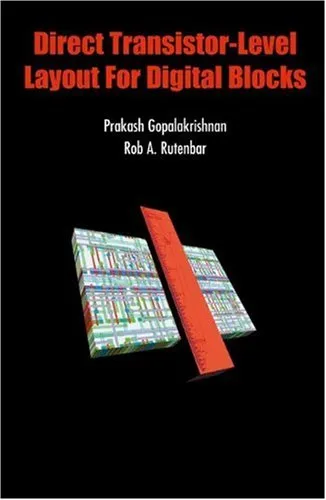Direct Transistor-Level Layout for Digital Blocks
4.5
Reviews from our users

You Can Ask your questions from this book's AI after Login
Each download or ask from book AI costs 2 points. To earn more free points, please visit the Points Guide Page and complete some valuable actions.Related Refrences:
Introduction
"Direct Transistor-Level Layout for Digital Blocks" is an insightful and comprehensive work that addresses one of the most intricate and challenging aspects of VLSI (Very-Large-Scale Integration) design: translating high-level transistor designs into precise, manufacturable layouts for digital circuits. Written by Prakash Gopalakrishnan and Rob A. Rutenbar, this book dives deep into the nuances of modern microelectronic design, offering methods, strategies, and innovative techniques for achieving high-quality layouts with precision and efficiency.
At its core, the book brings together theoretical concepts, practical guidance, and application-specific methodologies that are invaluable for engineers, researchers, and students alike. As CMOS technology continues to scale down to nanometer dimensions, ensuring correct design at the transistor level has become even more critical. This book equips readers with the tools needed to navigate these challenges, making it an essential resource for those operating in the semiconductor industry.
Throughout its chapters, "Direct Transistor-Level Layout for Digital Blocks" guides readers through the principles of designing compact, robust, and manufacturable layouts. The authors focus on bridging the gap between circuit theory and physical implementation, allowing readers to translate conceptual designs into working ICs with minimal iterations. Designed to be both technically accurate and accessible, this book is ideal for both entry-level and experienced practitioners.
Detailed Summary
The book is structured to provide a progressive exploration of transistor-level layout design. Beginning with an overview of the foundational concepts of digital design, it gradually moves into the specifics of layout methodologies, challenges, and best practices. Readers are introduced to important topics such as:
- Fundamentals of CMOS and transistor-level design for digital circuits.
- Layout principles for performance optimization, power efficiency, and manufacturability.
- Techniques for reducing parasitics, managing interconnect delays, and improving signal integrity.
- Advanced tools and design automation systems tailored for transistor-level layouts.
Furthermore, the authors address key industry concerns such as design for yield, scaling challenges, and the importance of adhering to DRC (Design Rule Checks) to ensure correct manufacturing. Each chapter is supplemented with detailed illustrations, real-world case studies, and exercises to help readers reinforce critical concepts and apply them effectively.
Key Takeaways
By the end of this book, readers will glean substantial insights into:
- Essential strategies for converting transistor-level designs into efficient, manufacturable layouts.
- Optimizing layouts to meet both performance and cost constraints.
- Understanding the trade-offs inherent in layout design, such as area, power, and delay considerations.
- Using layout techniques to mitigate challenges in nanoscale CMOS technologies, including leakage and variability.
- Practical knowledge of modern CAD tools and their role in automating layout design while maintaining accuracy.
Famous Quotes from the Book
"Executing a well-crafted transistor-level design is an art form, merging engineering precision with an intuition for physical space."
"The ultimate goal of layout is not just to build circuits that work—but to build circuits that perform, scale, and thrive in modern manufacturing environments."
Why This Book Matters
The importance of "Direct Transistor-Level Layout for Digital Blocks" lies in its unique focus and practical approach. While many VLSI design books emphasize circuit theory or high-level design, this book stands out by shining a spotlight on the critical transition from abstract circuit representations to physical layouts. This is a step in the design flow where even small mistakes can have drastic consequences for performance, power, and yield.
As semiconductor designs continue to increase in complexity, mastering the techniques outlined in this book is indispensable for practitioners who aim to stay ahead in the industry. Additionally, by covering both fundamental principles and advanced techniques, the book appeals to a wide audience—ranging from beginners who want to gain a strong foundation, to seasoned professionals seeking to refine their skills and stay current with technological advances.
Gopalakrishnan and Rutenbar provide both a roadmap and a toolkit, empowering their readers to bridge theoretical knowledge with real-world design challenges. The result is a book that is educational, actionable, and invaluable to the future of digital design.
Free Direct Download
You Can Download this book after Login
Accessing books through legal platforms and public libraries not only supports the rights of authors and publishers but also contributes to the sustainability of reading culture. Before downloading, please take a moment to consider these options.
Find this book on other platforms:
WorldCat helps you find books in libraries worldwide.
See ratings, reviews, and discussions on Goodreads.
Find and buy rare or used books on AbeBooks.
1268
بازدید4.5
امتیاز0
نظر98%
رضایتReviews:
4.5
Based on 0 users review
Questions & Answers
Ask questions about this book or help others by answering
No questions yet. Be the first to ask!













